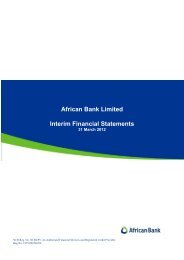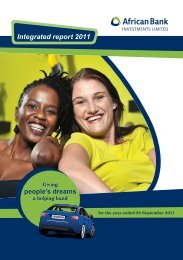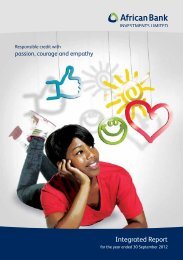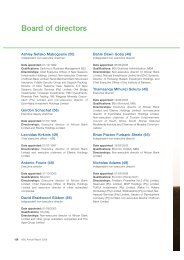Download - African Bank
Download - African Bank
Download - African Bank
You also want an ePaper? Increase the reach of your titles
YUMPU automatically turns print PDFs into web optimized ePapers that Google loves.
Notes to the annual financial statements (continued)<br />
for the year ended 30 September 2003<br />
1.7 Fixed assets<br />
Fixed assets are stated at original cost less accumulated depreciation. Major improvements to buildings are capitalised. Fixed<br />
assets other than land are depreciated on a straight-line basis over their expected useful lives.<br />
The estimated useful lives are as follows:<br />
Furniture – 6 years<br />
Computer equipment and software – 3 years<br />
Office equipment – 3 years<br />
Motor vehicles – 4 years<br />
Buildings – useful life (limited to 50 years)<br />
Leasehold improvements – over the shorter of the lease term or its useful life<br />
The carrying amounts of fixed assets are written down to their estimated recoverable amounts, where the estimated recoverable<br />
amount is lower than the carrying value.<br />
Repairs and maintenance are charged to the income statement when the expenditure is incurred.<br />
1.8 Taxation<br />
Income tax expense represents the sum of the tax currently payable and deferred tax.<br />
The tax currently payable is based on taxable profit for the year. Taxable profit differs from net profit as reported in the income<br />
statement because it excludes items of income or expenses that are taxable or deductible in other years and it further excludes<br />
items that are never taxable or deductible. The group’s liability for current tax is calculated using tax rates that have been enacted<br />
or substantively enacted by the balance sheet date.<br />
Deferred tax is the tax expected to be payable or recoverable on differences between the carrying amount of assets and liabilities<br />
in the financial statements and the corresponding tax basis used in the computation of taxable profit, and is accounted for using<br />
the balance sheet liability method. Deferred tax liabilities are generally recognised for all taxable temporary differences and<br />
deferred tax assets are recognised to the extent that it is probable that taxable profits will be available against which deductible<br />
temporary differences can be utilised.<br />
Deferred tax liabilities are recognised for taxable temporary differences arising on investments in subsidiaries and associates, and<br />
interests in joint ventures, except where the group is able to control the reversal of the temporary difference and it is probable that<br />
the temporary difference will not reverse in the foreseeable future.<br />
The carrying amount of deferred tax assets is reviewed at each balance sheet date and reduced to the extent that it is no longer<br />
probable that sufficient taxable profit will be available to allow all or part of the asset to be recovered.<br />
Deferred tax is charged or credited in the income statement, except when it relates to items charged or credited directly to equity,<br />
in which case the deferred tax is also dealt with in equity.<br />
Indirect taxes in the form of unrecovered value-added tax are grouped with the taxation expense in the income statement.<br />
Secondary tax on companies (STC) on ordinary dividends, net of STC credits earned, is expensed through the income statement in<br />
the period in which the dividend paid is accounted for.<br />
<strong>African</strong> <strong>Bank</strong> Investments Limited 102







